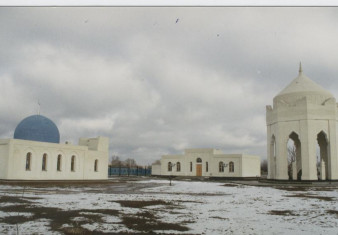 Cultural heritage
Cultural heritage
51.1202, 71.4702
The Nur-Astana Mosque (Kazakh: Нұр-Астана мешіті, Nur-Astana meşiti), is a mosque located in the city of Astana, the capital of Kazakhstan. It is third largest mosque in Central Asia.
The 40-meter (131-foot) height symbolizes the age of the Prophet Muhammad of when he received the revelations, and the height of the minarets are 63 meters (207 foot), the age Muhammad was when he died.
The mosque is located at the left riverbank in the city of Astana, construction first started in March 2005. The mosque was a gift in accordance with the agreement of the Kazakhstan President, Nursultan Nazarbayev and the Emir of Qatar, Hamad bin Khalifa. It has a capacity of 5,000 worshippers inside the mosque, including 2,000 for worshippers outside the mosque. The structure is made of glass, concrete, granite and alucobond measures.

In 50 km from the modern city of Atyrau, there is one of perspective tourist routes, regional memorial estate "Khan Ordaly Sarajshyk" who opens all ancient history of the Kazakh people.
The grave site of the great Kazakh poet of the 19th century, free-thinker and inspirer of the rebellion of Makhambet Utemisov is situated in Inder, Atyrau region, 40 km to the south-east from the village Inderbor.
Atyrau region is rich in its architectural monuments of culture, one of them is considered to be Zhuban Mausoleum.

Senek reserve is an architectural monument of the XVII - XX centuries, it represents a necropolis consisting of several sepulchral constructions and an old mosque.

One of the oldest and most beautiful architectural monuments of the city - Uspenski Cathedral is located in the heart of the city of Atyrau, on Issatay Taimanov street, just a few steps from the main square.

One of the leading places in the cultural life of Atyrau and the whole Atyrau region belongs to the Kazakh Drama Theater named after Makhambet Utemisov.



























